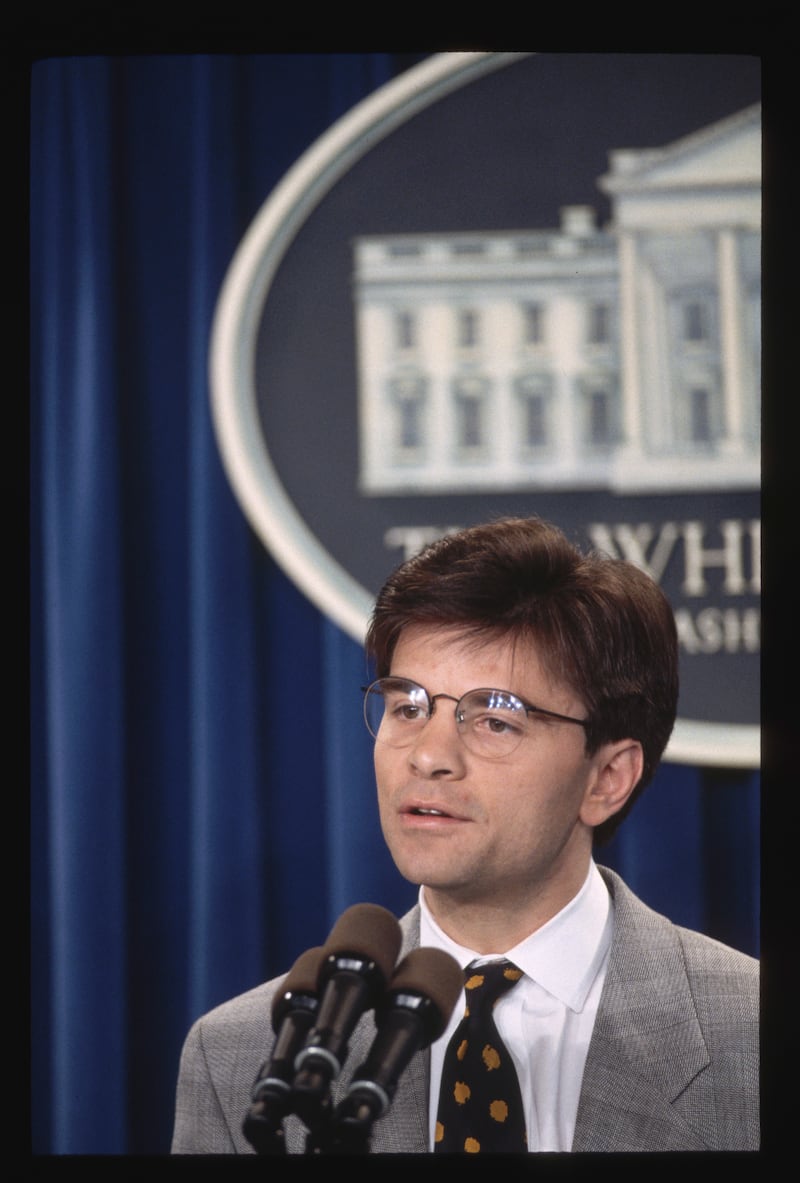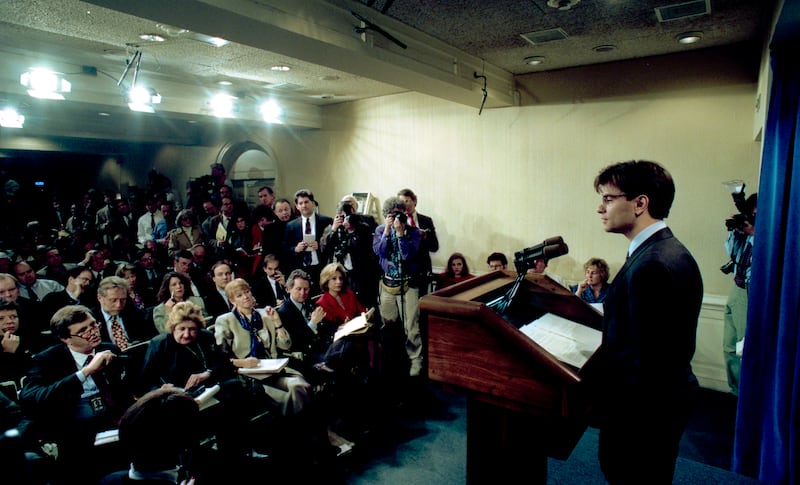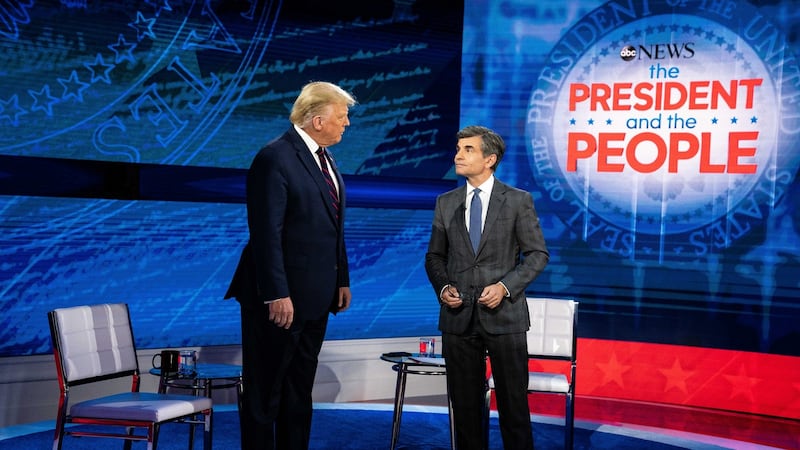On the morning of Bill Clinton’s inauguration in January 1993, a more intimate ceremony took place at Blair House, the historic brownstone dwelling across from the White House. The new president was there with his incoming staff, which included his 31-year-old communications director George Stephanopoulos. They had swept to a Democratic victory on a nimble, enterprising campaign defined by youth. But they were greenhorns on the national political scene and that morning encountered one of the veterans of the obscure realm of White House intelligence. Brent Scowcroft’s final duty as national security adviser was to brief Clinton and deliver the nuclear codes. His exit somehow stayed with Stephanopoulos during the Whitewater-rapids he experienced over the next four years, and he would resurrect it decades later in a written account: “Then Scowcroft – the stalwart and stoic adviser who had bolstered the morale of Sit’ [Situation] Room staffers after the defeats of Bush and Ford and the resignation of Nixon – walked out of Blair House alone in a rumpled raincoat and fedora, tears in his eyes.”
“Very ‘Smiley’, isn’t it?” Stephanopoulos laughs now at the suggestion that the image is reminiscent of espionage novelist John le Carré. Scowcroft died in 2020 at the age of 95 in Falls Church, a Virginian suburb of Washington, before Stephanopoulos set out to write an account of the fabled Situation Room which has served as the nerve centre of White House intelligence for seven decades of political administrations. But Scowcroft’s influence runs through the book – Jake Sullivan, the current national security adviser to Joe Biden, told Stephanopoulos that he considers Scowcroft his role model.
Stephanopoulos interviewed more than 100 veterans who passed through the “Sit’ Room” to try to piece together a complete account of its evolution. It was developed in the early days of the Kennedy administration in the wake of the Bay of Pigs diplomatic fiasco, with the old White House bowling alley repurposed into a four-room complex whose conference room is described in the book as having “all the charm of a cardboard box”. It was windowless, its walls absorbing the smoke of thousands of cigarettes and as many secrets and, over time, it became crammed with files and folders.
John F Kennedy loathed its interior and seldom visited; Lyndon B Johnson became deeply reliant on it and demanded constant updates from its round-the-clock duty officers, and Richard Nixon regarded it with an inherent distrust. What fascinated Stephanopoulos was the unheralded dedication of the staffers who served for years there with little recognition and less thanks.
RM Block
They are vigorously political and competent and professional and are doing this to serve their country. No credit for doing your job well and incredible blame if you make a mistake
— George Stephanopoulos
“And one of the things I came away with after interviewing all these people who served in the army, the navy, the airforce, the national security agency, the national intelligence agency is that the so-called deep state is packed with patriots who are determined to serve the presidency, above all. They are vigorously political and competent and professional and are doing this to serve their country. No credit for doing your job well and incredible blame if you make a mistake. And for that one in 15,000 chance that that phone call or that small piece of information turns out to be the most important thing you are ever going to come across.”

Through interviews and declassified documents, Stephanopoulos lays out the role the Situation Room played in the various crises of the day, from the assassination attempt on Ronald Reagan to the morning of September 11th, 2001, when Situation Room staffers were told to write their names and social security numbers on a page after refusing to evacuate. There’s a riveting account of the eerie days of the Yom Kippur War when Richard Nixon was, to all intents, unreachable, hiding out in an office in the Eisenhower building across the alley from the West Wing where he reportedly sat alone in his favourite chair and drank Ballintine’s scotch to fend off the accumulating pressures. It was, Stephanopoulos agrees now, a terribly lonely story.
“And quite scary. When you think about what is going on … to have this kind of nuclear crisis happening while Richard Nixon is in absolute political and personal turmoil, sitting up alone and often drunk in his study while this crisis is playing out in the Middle East. And then you learn years later that [Russian leader Leonid] Brezhnev wasn’t doing all that much better at the time! But yes, poignant too, and you get that from Sally Botsai, who was the first woman to serve in the Sit’ Room and who remembers a couple of things. She remembers the White House being locked down, most likely so that Nixon could take a walk through its halls alone. And she remembers that final goodbye, when she sort of expressed sadness for the country along with the idea that we go on, we carry on.”
‘The idea of the Situation Room was to centralise information. But one of the lessons that you learn from the LBJ experience is that information is not the same as insight’
— George Stephanopoulos
Nixon’s reluctance to rely on the Situation Room was partly informed by a belief that his predecessor had acquired a kind of “Situation Room Syndrome” because of his need for constant updates during the Vietnam War. It’s a theory Stephanopoulos believes has some substance and may have been informed by Johnson’s long career as a senator.
“I think he felt it personally. I think it was part control. Remember, he comes out of the Senate where the lesson of his life was getting things done. I think for him, getting information was action. The idea of the Situation Room was to centralise information. But one of the lessons that you learn from the LBJ experience is that information is not the same as insight. You can be desperate for every little bit of information that comes in but if your overall strategy is not wise, that information is almost useless.”

Curiously, despite being hermetically sealed from the outside world, the Situation Room mirrors the evolution of society. In the book, Stephanopoulos learns about the sexism encountered by Botsai and the women who followed her. Successive administrations adapted to technological advances, from the novelty of emails through to the day when Barack Obama watched, in real time, as the Navy Seals carried out the operation to assassinate Osama bin Laden. The reliance on CNN and other news sources is heavy. During the Clinton administration, Stephanopoulos was in the room after a missile strike on Baghdad in retaliation to intelligence about a plot to assassinate former president George Bush, who was on a visit to Kuwait.
“I actually didn’t write about this in the book but I remember it: we couldn’t get good information on where the missiles had landed, and we ended up getting it from CNN.”
Stephanopoulos is himself a familiar face on broadcast news, as anchor of Good Morning America on ABC, where he also fronts a Sunday morning current affairs show. His national profile and his life were transformed during the historic Clinton campaign, whose team he joined in the autumn of 1991, “literally”, he writes “on the ground floor: our headquarters was a storefront paint shop in downtown Little Rock”. That campaign was depicted in The War Room, an acclaimed documentary which focused on the strategists as much as the candidate.
[ Trumpocalypse: a conservative Republican rips the Trump presidency to shredsOpens in new window ]
By 1994, Stephanopoulos had registered as a national figure to the extent that his name appeared in the first series of Friends even if he himself did not make an appearance: while the apartment residents become excited after a pizza delivery mix-up ends up with them receiving the order of a “G Stephanopoulos”, leading to Rachel’s famous line: “Who’s George Snuffleupagus?” Stephanopoulos left the White House in December 1996 and wrote of his time there in his memoir, All Too Human, which was a sincere and at times self-flagellating account of his attempts to grapple with both his own flaws and those of the president he served, whom he describes in his memoir as “the dominant figure in my life” during his White House years.

“Our relationship was intense, intimate at times, but not a personal friendship,” he writes in All Too Human.
“The Clinton I know is the Clinton I show in this book: the politician and president at work, a complicated man responding to the pressures and pleasures of public life in ways I found both awesome and appalling.”
‘... we are no longer in a time where both sides engage in a presidential contest and are committed to base on facts and the rule of law and the peaceful transfer of power. I think it is the kind of division we have to combat in our daily lives’
— George Stephanopoulos
Stephanopoulos’s schedule has hardly slowed down since his White House years. Our conversation took place while he was headed to the airport on his way to an event. He recently told Seth Meyers that his day starts at 3am and joked that his working day is almost done when his two daughters, both in college, are having breakfast. ABC makes that alarm call worth his while: he is reportedly paid an estimated $15 million annually for anchoring a show that is consistently among the most watched in the country.
[ The Room Where it Happened: John Bolton's tedious and slightly unhinged memoirOpens in new window ]
He believes that America is right now in the midst of a prolonged “perilous” moment. “If you go back to what we were talking about the continuity of earlier administrations, the polarisation and deep division in our country is exactly what our adversaries have been working for and hoping for, when they have become, I believe, our greatest national security threat, those divisions. As I talked about on my show, we are no longer in a time where both sides engage in a presidential contest and are committed to base on facts and the rule of law and the peaceful transfer of power. I think it is the kind of division we have to combat in our daily lives.”
[ What will the New York Times's Trumpwatcher-in-chief do now?Opens in new window ]
As a liberal-leaning commentator in ABC, Stephanopoulos is keenly aware that there is a broad constituency to whom he represents one of the high-profile figures of an ideological chasm. At the end of our call, his voice, sunny in tone, turns sombre when he is asked how Americans might begin to start listening to one another again.
“It is one of the most crucial, if not the most crucial question our entire country faces. How we get back together again. It starts with a commitment to truth and facts. Because you can only have constructive debates if people are determined to engage in that in good faith.”
The Situation Room by George Stephanopoulos is published by Hachette.
- Sign up for push alerts and have the best news, analysis and comment delivered directly to your phone
- Find The Irish Times on WhatsApp and stay up to date
- Listen to our Inside Politics podcast for the best political chat and analysis





















